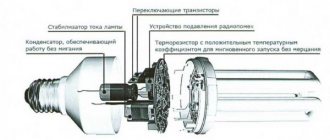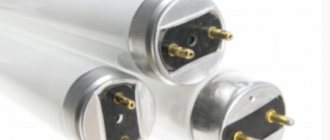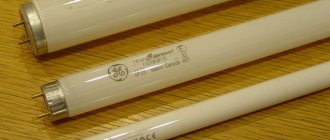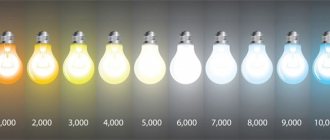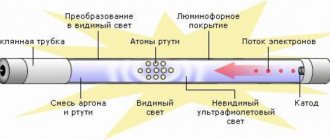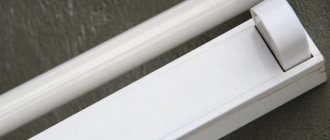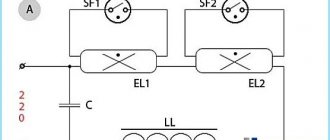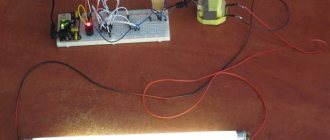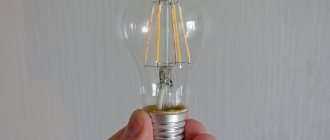A fluorescent lamp acts as a gas-discharge light source, in which the visible brightness is mainly created using a phosphor driven by ultraviolet radiation from the discharge. The luminous output from the product is several times greater than that of simple incandescent lamps with similar power indicators.
In addition, a fluorescent lamp has a longer service life, which can exceed the period of operation of a conventional device by twenty times. This is possible with high-quality power supply and compliance with restrictions on the number of switches on and off the device.
Fluorescent lamps can be purchased at almost any store that sells lighting devices. Low- and high-pressure mercury gas-discharge devices are most widespread. The latter type is mainly used for street lighting, as well as in high-power lighting installations. Low pressure devices are usually used in industrial and residential areas.
The fluorescent lamp is widely used to create lighting in public buildings: schools, hospitals, offices, etc. With the advent of compact devices with electronic ballast, which allows lamps to be inserted into ordinary sockets, fluorescent products are becoming popular in everyday life.
The demand for devices is due to their characteristics. First of all, they have high light output (a 20 W fluorescent lamp shines like a regular 100 W lamp), a long service life (about 2000 to 20 thousand hours versus 1000 for a conventional incandescent lamp), as well as diffused light and a wide variety of shades.
It is more advisable to use the devices to create general lighting in rooms with a large area. It is most effective to use products in conjunction with Dali systems, which improve lighting conditions, while energy consumption is reduced by more than half, and the service life of the devices is increased.
Fluorescent lamp is also widely used in workplaces, illuminated advertising, to improve the appearance of building facades, etc.
d. The devices find their place in the backlighting of LCD monitors and televisions. A variety of products are plasma panels.
Luminescent devices have characteristic features related to their operating principle.
When the lamp is turned on, a low-temperature electric arc runs through two electrodes located at different ends of the device. The lamp is filled with an inert gas and mercury vapor, which allows it to produce UV radiation that is not visible to humans. It is converted into light using the luminescence effect.
For more stable operation of devices, special electronic ballasts (EPGs) for fluorescent lamps are used. They ensure reliable operation of the lamps, eliminating humming and flickering, while power consumption is reduced by a quarter.
Luminescence is radiation that does not require heating of bodies and can occur in gaseous, liquid and solid bodies under the influence, for example, of impacts from electrons moving at speeds sufficient to cause excitation.
Phosphors are solid or liquid substances capable of emitting light under the influence of various types of pathogens.
Fluorescent and a number of other types of gas-discharge lamps use photoluminescence - optical radiation resulting from the absorption of optical radiation by bodies, but with a different wavelength.
Electric lamps in which electricity is converted into light directly, regardless of the thermal state of the substance, due to luminescence, are called luminescent.
Depending on the gas pressure in the lamp, there are low-pressure fluorescent lamps (LPLs) and high-pressure fluorescent lamps.
Fluorescent lamps are low-pressure gas-discharge lamps in which ultraviolet radiation resulting from a gas discharge, invisible to the human eye, is converted by a phosphor coating into visible light (the operating principle of a fluorescent lamp).
The device of fluorescent lamps.
A fluorescent lamp is a hermetically sealed glass tube, the inner surface of which is coated with a thin layer of phosphor. The air is removed from the tube and a small amount of gas (argon) and a dosed drop of mercury are introduced into it.
Inside the tube at its ends, in glass legs, are fixed tungsten bispiral electrodes connected to two-pin sockets that serve to connect the lamp to the electrical network using special sockets. When an electric current is supplied to the lamp, an electric discharge occurs in the mercury vapor between the electrodes; as a result of electroluminescence of the vapor, the lamp emits light.
And if previously fluorescent lamps looked mainly like long white tubes of various lengths, now fluorescent lamps with regular bases are ubiquitous for use in standard lamps and chandeliers. These are the so-called energy-saving lamps, which are becoming increasingly used along with halogen lamps and LED lamps.
Light in the hallway
The hallway is the first room of any house; here we welcome guests. However, it is in the hallway that, as a rule, there is no sunlight at all. So that the first impression of guests of the apartment does not turn out to be too gloomy, the hallway must be equipped with bright and high-quality lamps. Their light should be quite intense, but at the same time soft and friendly. It always lifts the mood, makes people more open and sociable.
Hallway lighting
Therefore, for general lighting of the hallway, fluorescent lamps are the best choice. They can be used in wall sconces (compact fluorescent lamps) and as strip lights, assembled on cornices under the ceiling along the entire perimeter. Their light will “spread” over the surface of the ceiling, lift it and make the ceiling appear to be floating.
The sconce light should have the best color rendering and a warm tone (for example, 930). And for strip lights, cold-glow tubular fluorescent lamps (860) are more suitable.
Advantages and benefits of fluorescent lamps.
The main advantages of fluorescent lamps compared to incandescent lamps are:
- higher efficiency (15 - 20%); high luminous efficiency and several times longer lamp life (with the same power expenditure, significantly greater illumination is achieved compared to incandescent lamps); the correct choice of lamps in terms of color can create lighting close to to natural; favorable emission spectra providing high quality color rendering; fluorescent lamps are much less sensitive to voltage increases, so they are economical to use in staircases and in rooms illuminated at night, when the network voltage is high (incandescent lamps, which are very sensitive to voltage increases, quickly burn out ); low cost; low surface brightness and low temperature (up to 50 ° C).
Basic parameters of lamps
Fluorescent lamps are characterized by the following main parameters.
Light parameters: 1) color and spectral composition of radiation; 2) luminous flux; 3) brightness; 4) pulsation of the light flux.
Electrical parameters: 1) power; 2) operating voltage; 3) type of supply current; 4) type of discharge and used luminous area.
Operational parameters: 1) light output; 2) service life; 3) dependence of light and electrical parameters on supply voltage and environmental conditions; 4) dimensions and shape of lamps.
The main feature that distinguishes lamps for mass use for lighting from the entire variety of fluorescent lamps is their combustion voltage, which is associated with the type of discharge used. Based on this feature, lamps are divided into three main types.
1. Arc discharge fluorescent lamps with a combustion voltage of up to 220 V. These lamps are most widespread in our country and European countries. Such lamps have a self-heating oxide cathode and ignite when it is preheated, which determines the main features of their design.
2. Arc discharge fluorescent lamps with a combustion voltage of up to 750 V. Such lamps (Slim line type) have become widespread in the USA, they operate without preheating the cathodes, and have a power of more than 60 W.
3. Glow discharge fluorescent lamps with cold cathodes. This type of lamp is used for advertising and signal lighting. They operate at low currents (from 20 to 200 mA) in high voltage installations (up to several kilovolts). Due to the small diameter of the tubes used, they can easily be molded into any shape.
A special group includes high-intensity lamps of increased power, having the dimensions of lamps of the first group. In such lamps it turned out to be necessary to use special methods of maintaining the pressure of saturated mercury vapor.
Let's consider the main parameters of fluorescent lamps of the first group. Of the parameters listed above that characterize fluorescent lamps, we have already considered the color and spectral composition of the radiation, luminous flux, power, type of discharge and the luminous area used. The values of other parameters of fluorescent lamps are given in Table 1. The average service life of lamps of all types with power from 15 to 80 W currently exceeds 12,000 hours with a minimum burning time of each lamp of 4,800 - 6,000 hours. During the average service life, the standard allows for a decline in luminous flux of no more than 40% of the initial one, and for a time equal to 70% of the average service life - no more than 30%.
Table 1
Characteristics of general purpose fluorescent lamps according to GOST 6825-74
| Types of lamps | Power, W | Current, A | Operating voltage, V | Dimensions, mm | Luminous flux, lm | Service life, h | |||
| Length with pins | Diameter | average | after minimum burning time | average | minimum | ||||
| LB15 LTB15 LHB15 LD15 LDTs15 | 15 | 0,33 | 54 | 451,6 | 27 | 820 820 800 700 600 | 600 540 525 450 410 | 15000 | 6000 |
| LB20 LTB20 LHB20 LD20 LDTs20 | 20 | 0,37 | 57 | 604 | 40 | 1200 1100 1020 1000 850 | 940 760 735 730 630 | 12000 | 4800 |
| LB30 LTB30 LHB30 LD30 LDC30 | 30 | 0,36 | 104 | 908,8 | 27 | 2180 2022 1940 1800 1500 | 1680 1455 1395 1180 1080 | 15000 | 6000 |
| LB40 LTB40 LHB40 LD40 LDTs40 | 40 | 0,43 | 103 | 1213,6 | 40 | 3200 3100 3000 2500 2200 | 2490 2250 2250 1900 1630 | 12000 | 4800 |
| LB65 LTB65 LHB65 LD65 LDTs65 | 65 | 0,67 | 110 | 1514,2 | 40 | 4800 4650 4400 4000 3160 | 3720 3310 3165 2705 2500 | 13000 | 5200 |
| LB80 LTB80 LHB80 LD80 LDTs80 | 80 | 0,865 | 102 | 1514,2 | 40 | 5400 5200 5040 4300 4800 | 4170 3745 3650 3100 2890 | 12000 | 4800 |
The brightness of fluorescent lamps of various colors and power ranges from 4 × 10³ to 8 × 10³ cd/m². The brightness of a lamp is related to its luminous flux Fl and geometric dimensions ratio
where L0 is the diameter-average brightness of the middle part of the lamp in the direction perpendicular to the axis, cd/m2; FL – luminous flux, lm; k is a coefficient that takes into account the decrease in brightness towards the ends of the tube, k = 0.92 for all lamps, with the exception of 15 W lamps, for which k = 0.87; d – inner diameter of the tube, m; lsv – length of the luminous part of the tube, m.
The unevenness of brightness along the diameter of the tube is associated with a change in the reflectance of the glass, which increases with increasing angle of incidence. It should be noted that all the indicated electrical and light parameters of fluorescent lamps are determined when the lamp is turned on with an exemplary measuring choke (DOI) at a rated stabilized voltage.
The luminous intensity of fluorescent lamps Iv in the direction perpendicular to their axis is related to the luminous flux by the relation
Iv = 0.108 × Fl.
The spatial distribution of luminous intensity of fluorescent lamps in the longitudinal plane is close to diffuse.
When fluorescent lamps are switched on to an alternating current network, in each half-cycle the discharge in the lamp goes out and re-ignites, which leads to a pulsation of the light flux. Due to the afterglow of the phosphor, the pulsation of the lamp's light flux is weakened compared to the pulsation of the discharge. The stroboscopic effect created by the pulsating light flux of fluorescent lamps is reduced by appropriately connecting groups of simultaneously switched fluorescent lamps to the power supply network, for example, on two or three opposite phases of the supply network.
| Figure 10. Dependence of the luminous flux of fluorescent lamps on the ambient temperature: 1 – with still air; 2 – at an air speed of 1 m/s; 3 – with a “thermal jacket” |
The electrical and light parameters of fluorescent lamps are determined by the parameters of the switching circuit and the network voltage. When the network voltage changes, the electrical parameters of the lamps and those of the light and operational parameters that are directly related to the electrical parameters also change. For any switching scheme, the parameters of fluorescent lamps depend significantly less on the supply voltage than the parameters of incandescent lamps.
The dependence of the parameters of fluorescent lamps on the pressure of saturated mercury vapor determines their sensitivity to changes in ambient temperature and cooling conditions. Figure 10 shows the dependence of the luminous flux on the ambient temperature. As is known, air, depending on the speed of its movement, significantly changes its cooling effect. Therefore, the dependence of the luminous efficiency of lamps, as can be seen from Figure 10, is determined not only by temperature, but also by the speed of air movement.
Disadvantages of fluorescent lamps
The main disadvantages of fluorescent lamps compared to incandescent lamps are:
- complexity of the switching circuit; limited unit power (up to 150 W); dependence on the ambient temperature (as the temperature drops, the lamps may go out or not light); significant reduction in luminous flux towards the end of their service life; pulsations of the luminous flux harmful to vision; acoustic interference and increased noisy operation; when the voltage in the network decreases by more than 10% of the nominal value, the lamp does not light up; additional energy losses in the ballasts, reaching 25 - 35% of the power of the lamps; the presence of radio interference; lamps contain substances harmful to health, so gas-discharge lamps fail lamps require careful disposal.
Specifications
Energy efficiency of various lamps
The main technical characteristics include:
- Color rendition. This is one of the main characteristics of a light source. Determined by the composition of the phosphor. Luminescent devices have a wide range of colors due to many different compositions. The most common ones for home use are devices with a color temperature of 2700 K, giving a warm natural tint. In advertising and architectural lighting, devices of different colors are used - pink, blue.
- Base. There are 2 forms of the base depending on the design - pin and cartridge. Pin sockets are used in luminaires that accept a U-shaped bulb. The cartridge sockets have a classic appearance with threads of different diameters. Used in home lamps.
- Voltage. Operating power supply is 220 V; series connection of spirit lamps operating at 127 V is less commonly used.
- Power. The most common are 18 V lamps. There are more powerful sources for spotlights, reaching 80 W.
- Life time. Can reach 40000 hours.
- Efficiency is above 20%.
- Physical dimensions. For example, Armstrong lamps have standard dimensions for a cell of 600x600 mm.
- Degree of protection from dust and moisture. Determines the possibility of safe operation under certain climatic conditions.
- Material of manufacture. Plastic, metal and others.
When choosing a lamp, you need to take into account the technical characteristics, as well as the parameters of the lamp in which the light source will be installed.
The principle of operation of fluorescent lamps.
The operating principle of a low-pressure fluorescent lamp is based on an arc discharge in low-pressure mercury vapor. The resulting ultraviolet radiation is converted into visible radiation in a layer of phosphor covering the inner walls of the lamp. The lamps are long glass tubes, into the ends of which legs are soldered, carrying two electrodes, between which there is a cathode in the form of a spiral.
Mercury vapor and an inert gas, mainly argon, are introduced into the lamp tube. The purpose of inert gases is to ensure reliable ignition of the lamp and reduce sputtering of the cathodes. A layer of phosphor is applied to the inner surface of the tube.
If a voltage of at least 500 - 2000 V per 1 m of tube length is applied to the electrodes inserted into the ends of a glass tube, which is filled with a discharged inert gas or metal vapor, then free electrons in the cavity of the tube begin to fly towards the electrode with a positive charge. When an alternating voltage is applied to the electrodes, the direction of electron movement changes with the frequency of the applied voltage.
In their movement, electrons meet neutral gas atoms, the filler of the tube cavity, and ionize them, knocking electrons out of the upper orbit into space. The atoms excited in this way, again colliding with electrons, again turn into neutral atoms. This reverse transformation is accompanied by the emission of a quantum of light energy.
Basic properties of low pressure mercury discharge
The main part of the radiation power of a low-pressure mercury discharge used in a fluorescent lamp is concentrated in the resonance lines of mercury with wavelengths of 253.65 and 184.95 nm. This radiation occurs in the discharge column at a mercury vapor pressure of 1 Pa and a current density of about 10 A/mm². The pressure of saturated mercury vapor is determined, as is known, by the temperature of the coldest part of the lamp bulb containing mercury in the liquid phase.
| Figure 2. Dependence of radiation fluxes of the resonance line of mercury λ = 253.65 nm on its vapor pressure: 1 – mercury with the addition of argon; 2 – pure mercury |
The emission of resonance lines depends on the pressure of mercury vapor, the type and pressure of the inert gas used in the lamps. This dependence for pure mercury and mercury with argon is shown in Figure 2. The increase in radiation flux in lamps filled with mercury vapor (curve 2 in Figure 2) at pressures up to 5 Pa is almost proportional to the mercury pressure; at high pressures, saturation occurs. The latter is due to the fact that with increasing pressure, the concentration of mercury atoms increases, leading to an increase in the number of collisions of mercury atoms with electrons, an increase in the number of excited atoms and, as a consequence, an increase in the number of emitted photons.
The introduction of an inert gas additive (curve 1 in Figure 2) increases the yield of resonant radiation of mercury atoms, since the presence of an inert gas, even in small concentrations, leads to an increase in pressure in the lamp. In a mercury discharge there is also a significant concentration of unstable atoms, which usually settle on the walls of the tube, increasing its temperature. As the pressure in a lamp filled with an inert gas increases, the probability of metastable atoms reaching the walls without colliding with other gas atoms or electrons decreases sharply. As a result, most of the mercury atoms go into an excited state with subsequent energy emission, which increases the luminous output.
Figure 3 shows the dependence of the resonant radiation output for the 253.65 nm mercury line on the current density J. Since the main source of resonant radiation is the discharge column, which occupies only part of the space between the electrodes, it is obvious that the luminous efficiency of the resonant radiation will depend on the length of the lamp , with an increase in which the influence of the cathode region, which is not involved in the creation of resonant radiation, will decrease. Figure 4 shows the dependence of the luminous efficiency of a fluorescent lamp on its length l.
| Figure 3. Dependence of the output of resonant radiation of mercury λ = 253.65 mm on current density | Figure 4. Dependence of the luminous efficiency of a fluorescent lamp on its length |
The voltage drop across the lamp decreases with increasing current density. This means that the potential gradient per unit length of the discharge column also decreases with increasing current density. The value of the voltage drop per unit length of the column depending on the current is necessary for calculations related to determining the parameters of the lamp. Figure 5 shows the dependence of the potential gradient E per unit column length on the current for lamps of different diameters, and Figure 6 shows the dependence of the voltage drop in the cathode region of the discharge Uк on the pressure and type of filling gas. For a fluorescent lamp with self-heating oxide cathodes, the cathode voltage drop, obtained by extrapolating the dependence of the voltage across the lamp on the length of the discharge column, is from 12 to 20 V. Therefore, for most types of fluorescent lamps, it is believed that the cathode voltage drop accounts for 10 - 15 V, and anode 3 – 6 V.
| Figure 5. Dependence of the potential gradient per unit length of the positive column on the current for lamps of different diameters, mm: 1 – 19; 2 – 25; 3 – 38; 4 – 54 | Figure 6. Dependence of the voltage drop in the cathode region of the discharge on the pressure and type of inert gas (mercury vapor pressure about 1 Pa) |
In modern fluorescent lamps, as a rule, oxide cathodes are used, operating in a self-heating mode with a cathode spot and increased thermionic emission from the entire surface. Oxide cathode designs are shown in Figure 7.
Figure 7. Designs of fluorescent lamp cathodes: a – cold glow discharge cathode; b – self-heating oxide cathode; 1 – cathode; 2 – anode; 3 – electrodes
The amount of activating substance contained in the oxide layer determines the actual service life of the lamps, since it is this substance that is consumed during the combustion process.
The ends of the tungsten wire, which forms the basis of the self-heating oxide cathode, are brought out of the lamp, which allows current to be passed through it both for processing and activating the cathode, and for preheating it in order to reduce the ignition voltage under operating conditions. During the formation of the oxide layer, an intermediate layer appears at the interface between the tungsten wire and the oxide paste due to the diffusion of alkaline earth metal ions into the surface layer of tungsten. This promotes the transfer of electrons from tungsten to the oxide. Their exit into the gas-discharge gap is ensured due to the low work function of heated barium. After the arc discharge is formed, the electron output is concentrated at the cathode spot located at the new lamp near the end of the electrode that is directly connected to the power source. As the barium evaporates into the lamp becomes depleted, the cathode spot moves along the electrode spiral to the opposite end, which leads to a gradual slight increase in the voltage across the lamp. At the end of the lamp's life, when barium has been consumed along the entire oxide cathode, the lamp's firing voltage increases significantly; a lamp switched on with conventional ballasts stops lighting.
Currently, there is no complete method for calculating cathodes. Therefore, their development is carried out on the basis of experimental data and represents one of the most labor-intensive processes for creating luminescent paws.
The optimal yield of resonant radiation depends on the pressure of saturated mercury vapor, which is determined by the temperature of the coldest part of the flask. The temperature of the ends of the bulb, in which the cathodes are located, is quite high, since the temperature of thermionic emission of the oxide cathode exceeds 1200 K. Thus, in the absence of any special devices in conventional fluorescent lamps, the area of the discharge column in the middle of the bulb will be the coldest. The dependence of the flask temperature tk on the power P1st released in the discharge column per unit external surface and depending on the outer diameter of the flask tube can be obtained from the relation
| Figure 8. Dependence of the temperature of the outer surface of a fluorescent lamp tube at an argon pressure of 400 – 500 Pa on the current and tube diameter, mm: 1 – 10; 2 – 25; 3 – 38 |
P1st = π × d2 × c × (tк – tв),
where c is a coefficient that weakly depends on the diameter of the tube d2; tв – ambient (air) temperature.
Due to the fact that it is difficult to measure the diameter of tubes on production lines, a certain range of diameters was selected for the manufacture of lamps of different power - 16, 25, 38 and 54 mm. The dependence of the temperature of the outer surface of the lamp tube on current and diameter is shown in Figure 8. The figure shows that with increasing current, that is, lamp power, in order to obtain a practically acceptable length and ensure the wall temperature, it is necessary to increase the diameter of the bulb tube. Lamps of the same power can, in principle, be created in flasks of different diameters, but they will have different lengths. To unify the lamps and the possibility of their use in various lamps, the lengths of fluorescent lamps are standardized and are 440, 544, 900, 1505 and 1200 mm.
Colors of fluorescent lamps.
Each inert gas and metal vapor has its own spectral composition of emitted light:
- tubes with helium glow with light yellow or pale pink light; tubes with neon - red light; tubes with argon - blue light.
By mixing inert gases or applying phosphors to the surface of the discharge tube, different shades of glow are obtained.
Fluorescent lamps for daylight and white light are made in the form of a straight or arc-shaped tube made of ordinary glass that does not transmit short ultraviolet rays. The electrodes are made of tungsten wire.
The tube is filled with a mixture of argon and mercury vapor. Inside, the surface of the tube is coated with a phosphor - a special composition that glows under the influence of ultraviolet rays produced by an electrical discharge in mercury vapor. Argon promotes reliable burning of the discharge in the tube.
Light in the kitchen
Here, more than anywhere else, you need multifaceted lighting - general and local (above the work and dining tables). In this case, it is advisable to use compact fluorescent lamps with a power of at least 20 W (warm light no worse than 840) as a general ceiling light. Lighting provided by strip fluorescent lamps above the work desk is especially convenient. Such lamps do not create glare on glossy and metal surfaces of kitchen utensils and practically do not create shadows. It is very important to use lamps with good color rendering (no worse than 830 - 930).
Lighting in the kitchen
Recycling of fluorescent lamps.
In light of modern trends, we strive to save energy. To do this, we buy energy-saving light bulbs, which are usually fluorescent. When purchasing fluorescent energy-saving lamps, you must take a responsible approach to the issue of their disposal, since they contain substances that are very harmful to the environment, in particular, mercury.
You need to know, understand and remember that these light bulbs cannot just be thrown into the trash and sent to a landfill along with the rest of the garbage. This is a criminal poisoning of the ecological environment of your area. Such lamps must be taken to special recycling points.
You can take energy-saving light bulbs for recycling to your management company and return them there completely free of charge. The law obliges management companies to install special containers to collect toxic lamps from the population.
Our electrician on duty in Korolev reported that a special container for sending fluorescent lamps for recycling is located at the entrance to the Globus hypermarket. Store address:
Korolev, st. Communalnaya, 1. An electrician in Shchelkovo confirmed that the Shchelkovo “Globus” also has a container for light bulbs (address: Shchelkovo, Proletarsky Prospect, no.
18). We received the same information from our master electrician in Pushkino: Pushkin’s Globus on Yaroslavskoye Shosse also accepts light bulbs for recycling. Light bulbs, batteries and mercury thermometers are then delivered to special points with which the network has entered into relevant agreements.
And our electrician in Sergiev Posad, who went out to carry out electrical installation work at one of the regional enterprises, could not find a company for recycling lamps in Sergiev Posad. I had to contact the Moscow collection point for fluorescent lamps.
If the material in this article was interesting and useful for you, share it with your friends on social networks. Perhaps this information will be very useful to someone. Sincerely, Royal Electrician in Mytishchi.
The fluorescent lamp, which was the result of a number of discoveries and research (more about this in the article history of the fluorescent lamp), has today become one of the main sources of artificial light, both in office premises and in private houses and apartments.
A number of advantageous differences from the incandescent lamp, which was popular a couple of decades ago, allowed the fluorescent lamp to compete quite successfully with “favorite” light sources, and also led to the creation of its more advanced and compact modifications. But this article will not talk about its advantages or disadvantages, but about how it works. All types of fluorescent lamps, whether the now popular “housekeepers” or the old long fluorescent lamps, are built and work on approximately the same principle . The only difference can be in the electronic circuit for connecting to the power source.
Connection options
Connection using electromagnetic balance (EMB)
The most common type of connection for a fluorescent light source is a circuit with a starter, where electronic ballasts are used.
The principle of operation of the circuit is based on the fact that as a result of connecting the power, a discharge occurs in the starter and the bimetallic electrodes are short-circuited.
The current in the electrical circuit of the conductors and starter is limited only by the internal choke resistance. As a result, the operating current in the light bulb increases almost threefold, the electrodes rapidly heat up, and after the conductors lose temperature, self-induction occurs and the lamp ignites.
Disadvantages of the scheme:
- Compared to other methods, this is a rather expensive option in terms of energy consumption.
- Start-up takes at least 1 – 3 seconds (depending on the degree of wear of the light source).
- Inability to work at low air temperatures (for example, in an unheated basement or garage).
- There is a stroboscopic effect of flashing the light bulb. This factor negatively affects human vision. Such lighting cannot be used for production purposes, because fast moving objects (for example, a workpiece in a lathe) appear motionless.
- Unpleasant humming of the throttle plates. As the device wears out, the sound increases.
The switching circuit is designed in such a way that it has one choke for two light bulbs. The inductance of the inductor should be enough for both light sources. 127 volt starters are used. They are not suitable for a single-lamp circuit; 220 Volt devices are needed there.
The picture below shows a chokeless connection. The starter is missing.
The circuit is used in case of burnout of filament lamps. A step-up transformer T1 and a capacitor C1 are used, which limits the current flowing through the light bulb from a 220-volt network.
The following circuit is used for light bulbs with burnt out filaments. However, there is no need for a step-up transformer, making the design of the device simpler.
Below is shown a method of using a diode rectifier bridge, which eliminates the flickering of a light bulb.
The figure below shows the same technique, but in a more complex design.
Two tubes and two chokes
To connect a fluorescent lamp, you can use a serial connection:
- The phase from the wiring is sent to the inductor input.
- From the inductor output, the phase goes to the contact of the light source (1). From the second contact it is sent to the starter (1).
- From the starter (1) it goes to the second contact pair of the same light bulb (1). The remaining contact is connected to zero (N).
Connect the second tube in the same way. First the inductor, then one contact of the light bulb (2). The second contact of the group is sent to the second starter. The starter output is combined with the second pair of light source contacts (2). The remaining contact should be connected to input zero.
Connection diagram for two lamps from one choke
The scheme provides for the presence of two starters and one choke. The most expensive element of the circuit is the inductor. A more economical option is a two-lamp lamp with a choke.
The video explains how to implement the scheme.
Fluorescent lamp design
The lamp consists of a glass bulb (can be of a wide variety of shapes and sizes), two (sometimes four) electrodes, an inert gas, mercury (vapor), phosphor and a trigger circuit (in housekeepers it is located inside the lamp body).
An electrode consists of two conductive electrical contacts (usually made of wire), to which electric current is supplied, a filament coated with a special emissive substance for more efficient emission of electrons during operation and a longer service life of the lamp itself.
Markings
As a rule, the marking consists of 3-4 characters. In the first place is the letter “L”, which means this is a fluorescent lamp. Following her, the shade of the glow is determined. There is also a “UV” marking meaning ultraviolet light. Next you can see the letter “C” or double “TsTs”, which informs us about the high quality of the product. The last in the list are symbols that indicate the type of product design: “B” - quick start, “U” - U-shaped, “P” - reflex, “K” - ring. The numbers indicated on the packaging indicate the power of the gas-discharge lighting source “W”.
Operating principle of a fluorescent lamp
When the electrical circuit of the lamp supplies current to the electrodes, they begin to gradually heat up and emit electrons. But these electrons are not enough to ignite between the electrodes the so-called glow discharge - a stream of ionized gas particles.
Then the part of the control circuit that is responsible for starting the lamp comes into operation. A short-term voltage pulse ignites the inert gas in the lamp, and then mercury vapor. The symbiosis of these substances, ionized by electric current, leads to the appearance of a glow in the ultraviolet region of the spectrum, invisible to us.
To convert ultraviolet light into visible light, a phosphor is used on the walls of the glass bulb. This results in a double conversion. First, electrons emitted by the electrodes of the lamp ionize the gas and mercury vapor, and then the ionized particles excite the phosphor, causing it to emit light visible to our eyes.
The difference in the principle of operation of an ordinary long fluorescent lamp and a “housekeeper” is only that in the first case the starting circuit consists of a choke (inductance), a capacitor and a starter. In the second, these functions are performed by a more complex electrical circuit, which includes other electronic components.
Now manufacturers use different phosphor compositions to change the color of fluorescent lamps or, as they say, its temperature.
A more yellow (warm) glow has a temperature of about 2700 K, natural daylight (white) - about 4100 K, brighter (cold light) - about 6000 K. Similar markings can be found on the lamps themselves. Category: Lighting sources The use of daylight lamps allows save energy compared to using conventional incandescent lighting fixtures. Specialists involved in working with electricity need to know about the principle of operation of a fluorescent lamp.
Types of fluorescent lamps
Varieties of fluorescent lamp structure
Classification of fluorescent lamps can be carried out according to power, temperature, shape, installation method, length. The most common are high and low pressure lamps. High-pressure devices are used on streets and in high-power lamps. Low pressure bulbs are suitable for chandeliers in residential and industrial premises.
Based on the type of installation, light sources are classified into the following groups:
- hanging;
- portable;
- ceiling;
- wall-mounted
According to the structure of the lamp there are:
- compact;
- ring;
- U-shaped;
- straight.
Most often, a ring and a straight short or long lamp are used for lighting. Rechargeable or battery-powered devices are also widely used.
Historical reference
The gas-discharge flask appeared back in 1856 and was called a Heissler tube. The use of a high-voltage coil made it possible to excite a green gas glow in it. A few years later it was proposed to coat the inner surface of the flask with a phosphor.
Products of a brighter white spectrum appeared only in 1926 thanks to the research of Edmund Germer. In their structure, they have already become similar to those that can be seen today.
Living room lighting
It makes sense to use fluorescent lamps in the living room only in sconces for bright, high-quality lighting of individual “areas” or illumination of works of art with diffused light. The light of these sconces, of course, must be white and of the highest quality (for example, 940). If the ceilings in the living room are low, then they can be raised and a cornice with fluorescent lamps installed around the perimeter, as in the hallway. And it is in the living room that you can give free rein to your imagination and come up with something special.
Living room lighting
Fluorescent lamp device
In order to understand the principle of operation of a single-lamp lamp, you need to get acquainted with its diagram. The lamp consists of the following elements:
- a glass cylindrical tube; two bases with double electrodes; a starter operating at the initial stage of ignition; an electromagnetic choke; a capacitor connected in parallel to the supply network.
The product flask is made of quartz glass.
At the initial stage of its manufacture, the air is pumped out of it and an environment is created consisting of a mixture of inert gas and mercury vapor. The latter is in a gaseous state due to excess pressure created in the internal cavity of the product. The walls are coated on the inside with a phosphorescent composition; it converts the energy of ultraviolet radiation into light visible to the human eye.
An alternating mains voltage is supplied to the electrode terminals at the ends of the device. The internal tungsten filaments are coated with metal, which, when heated, emits a large number of free electrons from its surface. Cesium, barium, and calcium can be used as such metals.
An electromagnetic choke is a coil wound to increase inductance on an electrical steel core with a high magnetic permeability.
The starter operates at the initial stage of the glow discharge process occurring in the gas mixture. Its body contains two electrodes, one of which is bimetallic, capable of bending and changing its size under the influence of temperature. It acts as a contactor and circuit breaker in the electrical circuit in which the inductor is connected.
Classification of gas-discharge devices with phosphor
All fluorescent lamps are divided into certain types and categories, in accordance with their parameters and technical characteristics.
According to spectral radiation, the types of fluorescent light bulbs are:
- Standard. They use a single layer of phosphor, creating different tones and shades of white. They are used in lighting systems for residential, administrative and industrial facilities.
- Improved. In such lamps, the inner side of the bulb is coated with phosphor in 3-5 layers. This structure significantly improves the quality of shades, and the light output is 12% higher than that of standard products. They are used for illumination and illumination of exhibition halls, shop windows and other similar objects.
- Special purpose. Here the chemical composition of the gas mixture and mercury changes, after which a spectrum with a given frequency is obtained. They are used in specific lamps for hospitals, concert halls and other places where even, stable light with specified parameters is required.
Operating principle of a fluorescent lamp
How does a fluorescent lamp work? First, freely moving electrons are formed. This occurs when the AC power supply is turned on in the areas around the tungsten filaments inside the glass cylinder.
These filaments, by covering their surface with a layer of light metals, emit electrons as they heat up.
The external supply voltage is not yet sufficient to create an electron flow. As they move, these free particles knock out electrons from the outer orbits of the inert gas atoms that fill the flask. They are included in the general movement.
At the next stage, as a result of the joint work of the starter and the electromagnetic choke, conditions are created for an increase in current strength and the formation of a glow gas discharge. Now comes the time to organize the light flux.
The moving particles have sufficient kinetic energy necessary to transfer the electrons of the mercury atoms, which are part of the lamp in the form of a small drop of metal, to a higher orbit. When an electron returns to its original orbit, energy is released in the form of ultraviolet light. Conversion to visible light occurs in a layer of phosphor covering the inner surface of the bulb.
Comparison with other light sources
LL-type products differ significantly from both aging incandescent lamps and progressive LED lamps.
Compared to the first ones, they consume 5 times less electricity, while providing the same level of light flux saturation. But they are somewhat inferior to LED devices in terms of power combined with energy consumption.
The table clearly shows in numbers how much more profitable it is to use more modern sources of high-quality lighting instead of traditional Edison light bulbs
True, an incandescent lamp burns with the same intensity throughout its entire operating period, while fluorescent lamps lose some of their saturation due to the burnout of the inner layer that reflects ultraviolet light.
LED products become somewhat dim during operation due to degradation of the working diodes. And in some models it is possible to adjust the brightness of the lighting using a dimmer.
Incandescent or fluorescent lamps do not provide this function. But this convenient mode in LED devices is not free and you will have to pay an additional amount for it.
In terms of the level of structural fragility, incandescent lamps and fluorescent lamps are similar, since they have a glass bulb. In this regard, ice modules are more resistant to shock and mechanical damage. And the absence of any harmful or toxic elements inside makes them much more attractive for use at home.
The highest costs for the entire operating period are incurred by the use of incandescent lamps. Luminescents consume energy within reasonable limits, and LEDs make it possible to reduce costs to the very minimum.
As for the financial side, initially an incandescent light bulb costs less than others. However, given its working life of only 1,000 hours, this can hardly be considered a pronounced advantage.
The basic price of fluorescents is higher, however, and they last much longer. As reputable manufacturers say, they last for 10,000-15,000 hours if the number of daily activations does not exceed 5-6 times.
LED modules can boast even better performance, but you will also have to pay much more for this pleasure, and this is not advisable in all cases. Although the tendency to replace some light sources with others can be seen everywhere. We wrote about the need to replace fluorescent light bulbs with LED ones and the procedure for performing this work here.
Why do you need a choke in a fluorescent lamp?
This device works from the moment of start and throughout the entire glow process. At different stages, the tasks performed by it are different and can be divided into:
- turning on the lamp; maintaining normal safe mode.
At the first stage, the property of the inductor is used to create a voltage pulse of large amplitude due to the electromotive force (EMF) of self-induction when the flow of alternating current through its winding stops. The amplitude of this pulse directly depends on the magnitude of the inductance. It, summed with the alternating mains voltage, allows you to briefly create a voltage between the electrodes sufficient for a discharge in the lamp.
When a constant glow is created, the choke acts as a limiting electromagnetic ballast for the low-resistance arc circuit. Its goal now is to stabilize operation to prevent an arc fault. This uses the high inductive reactance of the alternating current winding.
Arguments for
- Such lighting devices can last tens of times longer than incandescent lamps, provided they have a stable power supply without significant voltage fluctuations and limiting the number of starts. When turned on, a special composition burns out and crumbles on the electrodes, protecting the tungsten filament from overheating and ensuring discharge stability, which reduces the service life of the light source. The ends of the bulb darken and the lamp begins to flicker.
- The light output of fluorescent lamps per unit of power consumption is approximately 3-4 times greater than that of incandescent lamps.
- They are varied in color, their emission spectrum is closer to that of the sun.
- Diffuse glow from the entire surface of the bulb, not the tungsten filament.
Operating principle of a fluorescent lamp starter
The device is designed to control the process of putting the lamp into operation. When the mains voltage is initially connected, it is completely applied to the two starter electrodes, between which there is a small gap. A glow discharge occurs between them, in which the temperature increases.
One of the contacts, made of bimetal, has the ability to change its size and bend under the influence of temperature.
In this pair, it serves as a moving element. An increase in temperature leads to a rapid short circuit between the electrodes. Current begins to flow through the circuit, which leads to a decrease in temperature.
After a short period of time, the circuit breaks, which is a command for the self-induction EMF of the inductor to come into operation. The subsequent process was described above. The starter will only be needed the next time it is turned on.
Bathroom lighting
There is only one requirement for lighting in the bathroom - the light must be comfortable and bright enough so that a person can freely navigate in this small room. The light should have warm shades (up to 3300 K).
Bathroom lighting
These articles may also be of interest to you:
- Lighting design
- Selection and installation of switches
- Artificial lighting of the apartment
- Types of electric lamps
Minuses
- Relatively high cost.
- Fluorescent lamps are a potential hazard as each bulb contains up to 5 mg of mercury, which is highly toxic and can cause harm to health and the environment.
- Gas discharge lamps are sensitive to low and high temperatures. May not work at air temperatures below -20 °C and above +50 °C.
- Sensitive to humidity.
- There is a delay in switching on as it takes time for the lamp to warm up.
- The light spectrum is unusual for vision, resulting in distortion of color perception. Flickering at twice the mains frequency.
Philips products
Master TL-D 90 De Luxe – fluorescent lamp G13, T8, with a color rendering index of 93 Ra8, color temperature 65000 K – cold daylight. Available in three versions:
- 18W/965 1SL – 18 W fluorescent lamps with a nominal luminous flux of 1150 lumens and a nominal luminous efficiency of 63.9 Lm/W;
- 58W/965 1SL – 58-watt light sources with a nominal luminous flux of 4550 lumens and a nominal luminous efficiency of 77.8 Lm/W;
- 36W/965 1SL – 36 W fluorescent lamps with a nominal luminous flux of 2800 lumens and a nominal luminous efficiency of 77.8 Lm/W.
The high color rendering index allows you to see rich, rich and natural colors, which makes the lamp indispensable in hospitals, printing houses, beauty salons, museums, dental offices and shops. The lamps are distinguished by a high-quality fluorescent coating using three-band phosphor and an almost complete absence of illumination level reduction.
Master TL-D Xtreme 36W/840 1SL – fluorescent lamp 36-watt power, two-pin, cool white color with color rendering index 85 Ra8, nominal luminous flux 3250 lumens, nominal luminous efficiency 90 Lm/W. Its feature is an increased service life, reaching 66,000 hours, which is important for places where the cost of replacing lamps is high due to the height of the room, the need to interrupt work, or where the light is on constantly - in tunnels, drilling rigs, in continuous production conditions.
Master PL-C 18W/830/2P 1CT is a two-pin fluorescent lamp of 18-watt power with a G24d-2 base, warm white color 3000 K, with a color rendering index of 82 Ra8, a nominal luminous flux of 1200 lumens, a nominal luminous efficiency of 67 Lm/W. Designed for general overhead lighting in leisure facilities, retail and office buildings. The Philips Master Pl-C fluorescent lamp uses original bridge technology, guaranteeing optimal performance, better illumination and high efficiency. The two-contact model has a removable base and is used with electronic ballasts.
Criterias of choice
1. Shape and dimensions. Glass flasks and cartridges differ greatly in these parameters. The common form of fluorescent fixtures is a straight tube. Its diameter is a multiple of one-eighth of an inch. So, the size of a lamp with a diameter of 1 inch is T8. Sizes range from T2 to T17. Compact fluorescent lamps are typically U-shaped and spiral-shaped. Of course, appearance does not affect the operation of the lamp, but spiral models are a little more expensive, since their production is more difficult.
2. Start. Available with starter, electronic or electromagnetic ballast.
3. Power. Ranges from 3 to 85 W. The luminous flux of incandescent lamps is 3-4 times lower than that of fluorescent lamps, so the required power should be selected based on the required brightness. Fluorescent lamps, whose power is 25-30 W, will replace conventional 100-watt electrical appliances. To replace a 75-watt one, an energy-saving light source of 9 watts is sufficient. And fluorescent lamps, whose power is 15 W, can replace a 60 W incandescent lamp.
A table of the ratio of luminous flux and power consumption of lamps of different types will help you understand all the nuances.
| Light flow | LED lamp | Incandescent lamp | Fluorescent Lamp |
| lumen | watt | watt | watt |
| 450 | 4-5 | 40 | 9-13 |
| 800 | 6-8 | 60 | 13-15 |
| 1,100 | 9-13 | 75 | 18-25 |
| 1,600 | 16-20 | 100 | 25-30 |
| 2,600 | 25-28 | 150 | 30-55 |
4. Base. The following types are common:
- B mount;
- screw (Edison) base E;
- single-sided two-pin G.
The number after the letter indicates either the diameter of the base type B or E, or the distance between contacts in mm in type G bases.
Mostly, compact fluorescent lamps with an E27 base with a diameter of 27 mm and E14 lamps with a diameter of 14 mm are used in chandeliers and sconces.
5. Color of light. Corresponds to the temperature of a black body emitting with a certain chromaticity. As temperature increases, the blue part of the spectrum increases and the red part decreases. It is measured in kelvins. The subjective sensation of a person looking at light of a certain color is called color sensation. Basic colors of light and their corresponding color perception:
- 2700 K – super warm white;
- 3000 K – warm white light;
- 3500 K – white light;
- 4000 K – cold white light;
- 5000 K and more – daylight.
6. Color rendition. Shows how natural the surrounding objects look in the light of the lamp. Measured by the color rendering index Ra. Light sources with the same color may have different color rendering due to the different spectrum of emitted light. For sunlight the coefficient is 100.


